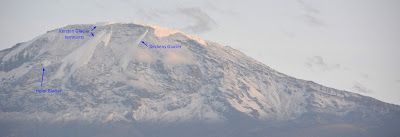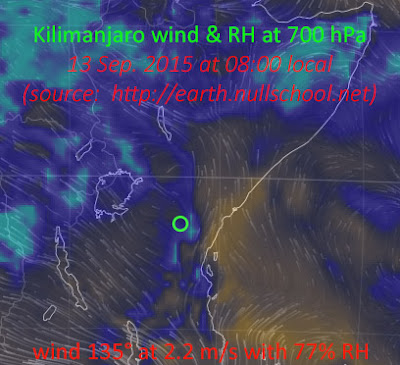This month's issue of KLM's in-flight magazine iFly has some nice photographs of climber Will Gadd, shot on Kibo's summit glaciers by Christian Pondella. One of these is above, showing the upper margin of Kersten Glacier as viewed from Uhuru Peak. Many summit climbers have enjoyed this view, with Mt. Meru ~70 km to the west through very clear air.
Despite continuing shrinkage of Kilimanjaro's glaciers, the steep margins remain impressive. For scale, the climber in this image indicates that the cliff is ~18 m or 60 ft. high. The meltwater lake at the base has been present there for many years. Has anyone ever seen it not frozen?
Most interesting here is how early-morning light highlights the stratigraphy of Kersten Glacier. As other perspectives also show, there are "bands" or "layers" of ice which are darker than those above or below. Thinking back through time, these likely formed when the surface was exposed for a period of time - probably years or decades - either due to no net snow accumulation (neutral mass balance) and/or to ablation (negative mass balance). Instead, dust accumulated and was subsequently buried during an interval of snow accumulation. Now exposed at the vertical wall, the high concentration of dust absorbs more solar radiation than the surrounding, relatively-clean ice, and absorbed energy leads to melting and sublimation -- highlighting the stratigraphy. Such features provide evidence of a complex ice history on Kilimanjaro.
Tuesday, December 15, 2015
Tuesday, December 8, 2015
Snowy November, slope glacier changes
During the month of November, net snow accumulation on the Northern Ice Field amounted to 19 cm. During this very strong El Niño year we expect additional snowfall through at least December, as the short rains continue. The image above shows fresh snowcover as seen from Moshi just after sunrise this morning (8 December 2015); thanks as always to Simon at SENE for keeping us updated.
Some readers may recall seeing other photos from Moshi posted here previously. Despite slight differences in lighting and snowline elevation, at first glance these appear quite similar. However, even at considerable distance, with thin snowcover, and a short 1-2 year timespan, changes in the glaciers are apparent upon close inspection.
Here are links to approximately the same view, one year ago (5 Dec. 2014; lower photo) and two years ago (24 Nov. 2013).
Three locations at which change is evident are labeled on today's image, including 1) Heim Glacier, a remnant of ice which was recently contiguous with ice to the left, and not long ago flowed nearly from the crater rim (as the Deckens does today); 2) Kersten Glacier, showing overall shrinkage in area with increasing separation of the upper and the slope remnants; and 3) Deckens Glacier, which will very soon become disconnected from the upper portion. All of these glaciers formerly comprised the Southern Ice Field.
Recession of other glaciers on Kilimanjaro also continues, based on annual field observations, GPS mapping, and imagery. The Furtwängler Glacier, for example, has been reduced to 4 fragments and continues to thin. At the Northern Ice Field - Kibo's largest ice body - the vertical margins continue retreating (ablating), and thinning of the glacier in some locations is creating new holes. Somewhat surprisingly however, this is not the case at the highest, flat section of the glacier. At the AWS, the 19 cm accumulation increase during November brings the ice surface to exactly the same elevation as it was on 1 Oct. 2011, meaning that the specific mass balance of that section has been neutral for 4 years! This portion of the Northern Ice Field will almost certainly be the last ice to disappear from the mountain.
Tuesday, September 29, 2015
Clouds and humidity
Here is another view of the constantly-changing clouds we watched
September 13th on Kibo, ascending from Karanga to Barafu Camp (see
below or here for the image posted last week).
According to our Northern Ice Field AWS measurements that morning, wind speeds were rather modest at the time (~7 m/s); data from NCEP (see below) agree reasonably well. The image above suggests a sharp boundary between small parcels of air with contrasting moisture content, and as shown by the image below - with Kibo's location indicated by the green circle - humidity at 500 hPa (summit level) was variable that morning. The humidity contrast is even more pronounced at the 700 hPa level (see image; brown color is less than approx. 20%, cyan blue is greater than ~95%). Although wind speeds were low by all measures, direction varied with altitude. We were watching cream be added to coffee, in slow motion.
The spell-binding display we witnessed was no doubt the result of numerous interacting factors, in addition to these. Mountain fieldwork is always interesting!
One additional image showing NCEP humidity data follows. Note the high humidity (blue) at 500 hPa over a broad area around Kilimanjaro. Interestingly, my field notes early that morning read: "Humidity increased during the night; the air feels and smells different, and both sides of the tent fly are frosty. Sky clear." Later that afternoon we experienced a snow squall which blanketed the summit crater with ~5 cm of new snow (image 5, previous post), our only precipitation of the expedition.
According to our Northern Ice Field AWS measurements that morning, wind speeds were rather modest at the time (~7 m/s); data from NCEP (see below) agree reasonably well. The image above suggests a sharp boundary between small parcels of air with contrasting moisture content, and as shown by the image below - with Kibo's location indicated by the green circle - humidity at 500 hPa (summit level) was variable that morning. The humidity contrast is even more pronounced at the 700 hPa level (see image; brown color is less than approx. 20%, cyan blue is greater than ~95%). Although wind speeds were low by all measures, direction varied with altitude. We were watching cream be added to coffee, in slow motion.
The spell-binding display we witnessed was no doubt the result of numerous interacting factors, in addition to these. Mountain fieldwork is always interesting!
One additional image showing NCEP humidity data follows. Note the high humidity (blue) at 500 hPa over a broad area around Kilimanjaro. Interestingly, my field notes early that morning read: "Humidity increased during the night; the air feels and smells different, and both sides of the tent fly are frosty. Sky clear." Later that afternoon we experienced a snow squall which blanketed the summit crater with ~5 cm of new snow (image 5, previous post), our only precipitation of the expedition.
Wednesday, September 23, 2015
Fieldwork: routine tasks & new measurements
Our group has just returned from a 3-day intensive period of
fieldwork on the summit glaciers of Kilimanjaro. Despite loosing one
day due to a tragic accident on the mountain, hard work by all rendered our efforts largely successful.
Dry and stable weather prevailed through most of our 12 days on the mountain, but during our final afternoon of fieldwork we worked through intensive snowfall followed by colder (-6.6° C) and windier (8.0 m/s) conditions. Leo inspired us by being either entirely undaunted, or so focused on his work that he didn't notice!
Among the exciting new results is a tremendous dataset resulting from a dense network of Northern Ice Field radar profiles. Two different systems and multiple different antennas yielded beautiful data which will aid in understanding the variability of ice thickness, stratigraphic patterns, and water content within the ice. To our knowledge these were the first efforts to deploy radar equipment on Kilimanjaro glaciers, and we thank those who entrusted us with their instruments. In addition, two boxes of ice samples were collected and safely transported to Heidelberg University. There we will hopefully obtain additional radiocarbon dates from the ice, and other analyses will be conducted in conjunction with the University of Maine.
Additional images and details will be forthcoming. Here we would like to acknowledge tremendous support for this equipment-intensive effort from our entire SENE crew. Our guides Jackson, Augustino and John did a great job, Godlisten's food was outstanding, and we would especially like to thank all of our porters - who remained invariably cheerful despite some large, cumbersome loads. We also acknowledge partial financial support for this work from the National Geographic Society's Global Exploration Fund - Northern Europe, and the University of Maine's Climate Change Institute.
Image 1 (above): Loading some of our gear at Mbahe, for transport to Umbwe Gate. Note barely-visible large metal case on the rear roof; although weighing less than 23 kg, carrying this up 4000 m was far from trivial. Thank you Daruesh!
Image 2: Rapidly-changing, "gossamer thin" clouds engrossed us during our ascent from Karanga to Birafu camps (13 Sep.). The slight decrease in mid-tropospheric stability was probably associated with a seasonal change in regional circulation. Part of the Rebmann Glacier is visible at the crater rim.
Image 3: Helene and Pascal heading north on a radar transect from the AWS.
Image 4: Leo and an assistant returning from an east-west radar transect.
Image 5: Fresh snow and clearing sky to the east, following the afternoon snowstorm of 17 September. Reusch Crater slope is visible to the right.
Dry and stable weather prevailed through most of our 12 days on the mountain, but during our final afternoon of fieldwork we worked through intensive snowfall followed by colder (-6.6° C) and windier (8.0 m/s) conditions. Leo inspired us by being either entirely undaunted, or so focused on his work that he didn't notice!
Among the exciting new results is a tremendous dataset resulting from a dense network of Northern Ice Field radar profiles. Two different systems and multiple different antennas yielded beautiful data which will aid in understanding the variability of ice thickness, stratigraphic patterns, and water content within the ice. To our knowledge these were the first efforts to deploy radar equipment on Kilimanjaro glaciers, and we thank those who entrusted us with their instruments. In addition, two boxes of ice samples were collected and safely transported to Heidelberg University. There we will hopefully obtain additional radiocarbon dates from the ice, and other analyses will be conducted in conjunction with the University of Maine.
Additional images and details will be forthcoming. Here we would like to acknowledge tremendous support for this equipment-intensive effort from our entire SENE crew. Our guides Jackson, Augustino and John did a great job, Godlisten's food was outstanding, and we would especially like to thank all of our porters - who remained invariably cheerful despite some large, cumbersome loads. We also acknowledge partial financial support for this work from the National Geographic Society's Global Exploration Fund - Northern Europe, and the University of Maine's Climate Change Institute.
Image 1 (above): Loading some of our gear at Mbahe, for transport to Umbwe Gate. Note barely-visible large metal case on the rear roof; although weighing less than 23 kg, carrying this up 4000 m was far from trivial. Thank you Daruesh!
Image 2: Rapidly-changing, "gossamer thin" clouds engrossed us during our ascent from Karanga to Birafu camps (13 Sep.). The slight decrease in mid-tropospheric stability was probably associated with a seasonal change in regional circulation. Part of the Rebmann Glacier is visible at the crater rim.
Image 3: Helene and Pascal heading north on a radar transect from the AWS.
Image 4: Leo and an assistant returning from an east-west radar transect.
Image 5: Fresh snow and clearing sky to the east, following the afternoon snowstorm of 17 September. Reusch Crater slope is visible to the right.
Labels:
fieldwork,
friends,
images,
regional weather,
snowcover
Wednesday, August 19, 2015
Space Station view
Astronaut Scott Kelly flew over Kilimanjaro a couple mornings ago (17 August) and tweeted the image above. This is a low-resolution version of what NASA will hopefully post eventually, yet adequate to see some interesting features:
- White areas on the mountain are primarily glacier ice. Very small areas of seasonal snow are visible within the summit caldera, on the western flank (e.g., Breach area), and to a greater extent on the south side - formerly occupied by the Southern Ice Field.
- The mountain's largest ice body (Northern Ice Field) is the northernmost glacier, and both the split and more-recently developing holes (n=6) are visible; the glacier's total area is less than 1 km^2. See the post below for detail on this glacier, about a month prior.
- The east-west oriented ice body to the southwest of the Reusch Crater is the largest remnant of the Furtwängler Glacier. Groups sometimes camp just south of this glacier.
- The Decken Glacier is the skinny (40-50 m wide), southernmost ice body visible above. Narrowing of this glacier has been quite rapid; the Heim Glacier (slightly to the west) underwent the same ablation pattern 5-10 years ago and is now just a tiny remnant at ~5,300 m.
- Kibo's adjacent peak Mawenzi is visible at the lower right corner of the image above, with the "Saddle" area in between.
- Amazingly, considering that the ISS is currently at an altitude of ~400 km above Earth, the trail above and below Birafu Camp is visible, as well as the trail between Karanga Valley and Birafu camps!
Tuesday, August 11, 2015
NIF ablation, upcoming fieldwork
Since installing our NIF AWS in February 2000, ablation of the horizontal glacier surface has required resetting the tower on 5 occasions. Until October 2011 when we reset the tower most recently, the interval between lowerings has ranged from 12 to 51 months. Yet for 4 years now, the horizontal mass balance has been more positive than negative, never lower in height than 15-20 cm below the Oct. 2011 datum, and currently only 5-10 cm below that level. However, the rate of ablation on Kibo often begins to accelerate during August, and considerable ice loss can occur before new snow accumulates in association with the short rains (typically Nov/Dec).
During July we measured 23 cm of net ablation at the AWS. With another 10 cm, the dirty, low-albedo surface of the NIF will be exposed once again. This dark surface - possibly centuries old - was briefly exposed at the AWS in September 2013 before ablation was checked by a snowfall event which was followed by early arrival of the short rains. In contrast, extended dry seasons in 2000, 2003, and 2008 had the opposite effect, and all required lowering of the AWS shortly thereafter. Albedo is the primary control on ablation here, by governing the receipt of net radiation. (Note in the upper image from last month that snowcover remains only on higher-elevation portions of the NIF, maintaining higher albedo and reducing ablation.)
By the end of this month (August), we will have a better estimate of when the tower will need to be reset. Fortunately, plans are underway for fieldwork during September, when we can carry out the work if necessary.
Our 2015 fieldwork aspirations are ambitious. We will be an international group of 5 scientists, ably guided by the one-and-only Simon Mtuy of Summit Expeditions (SENE), and working for 6 days at the summit. Annual service will be done on the AWS - in addition to possibly resetting the tower - and a number of sensors will be swapped out for calibration. We will also conduct the first thorough survey of NIF ice thickness and stratigraphy, by a series of radar transects. A small number of ice cores will be drilled and transported in frozen state back to labs for additional radiocarbon dating, as well as micrometer-resolution analysis of impurities. And as always, we will continue documenting both retreat and thinning of all the mountain's glaciers.
Collaborating Institutions for 2015 fieldwork:
* Dept. of Geosciences, Univ. of Massachusetts Amherst (USA) - lead
* Institute of Environmental Physics, Univ. of Heidelberg (Germany)
* Climate Change Institute, Univ. of Maine (USA)
* Alpine Cryosphere and Geomorphology Research Group,
Dept. of Geosciences, Univ. of Fribourg (Switzerland)
* Analytical Chemistry Group, Laboratory for Radiochemistry and
Environmental Chemistry, Paul Scherrer Institute (Switzerland)
Friday, March 6, 2015
Tropical Cyclone 15S [updated]
Tropical Cyclone 15S is currently in the Mozambique Channel, as shown by the image above from NASA's Terra satellite processed by the NASA Goddard MODIS Rapid Response Team. The image was acquired at 10:40 East Africa Time on March 6th.
Will the circulation associated with 15S influence Kilimanjaro snowfall? We will be keeping an eye on this, for the circulation around prior cyclones seems to have been associated with precipitation at this time of year - as moisture is delivered from the Congo Basin. Here is a previous discussion, initiated by conversations with Timba at Ahsante Tours & Safaris.
Forecasters at the Joint Typhoon Warning Center anticipate 15S wind speeds to increase over the next few days. The duration that the cyclone remains over warm water may determine the impact on Kilimanjaro. We will provide an update next week!
[UPDATE 3/11: No apparent influence this time. Mid-tropospheric circulation to the north (i.e., Kilimanjaro) seems not to have been substantially influenced by 15S, and westerly flow never developed. We'll keep an eye on future cyclones this season.]
Wednesday, March 4, 2015
February snow
February on Kilimanjaro is typically a rather dry month, a mini dry
season sandwiched between the short-rains of roughly November-December,
and the long-rains during the March-April-May period. Last month
followed this pattern, excepting a brief, important event occurring
mid-month.
At the summit, snowfall began late on the 14th and appears to have continued all day on the 15th. The 16th may have been dry in the morning, but by evening telemetry data suggest that snowfall began again, with increased wind speed that may have caused drifting of the fresh snow. Reports from climbers on the mountain mention heavy snowfall at Arrow Glacier Camp and in the Western Breach. By early on the 18th the event was over and dry conditions again prevailed on into early March.
This February event is important because it was the largest snowfall event since the long-rains of 2014, totaling 16.5 cm. This is ~2 cm greater than the event of late-November into early-December 2014. Although events of this magnitude pale in comparison with those on other mountains, they must be viewed in context; the summit of Kilimanjaro is very dry. Snowfall on the summit glaciers adds mass to horizontal surfaces, and more importantly - a bright, smooth snow surface changes the energy balance both on the glaciers and on surrounding caldera surfaces adjacent to the vertical walls.
At the summit, snowfall began late on the 14th and appears to have continued all day on the 15th. The 16th may have been dry in the morning, but by evening telemetry data suggest that snowfall began again, with increased wind speed that may have caused drifting of the fresh snow. Reports from climbers on the mountain mention heavy snowfall at Arrow Glacier Camp and in the Western Breach. By early on the 18th the event was over and dry conditions again prevailed on into early March.
This February event is important because it was the largest snowfall event since the long-rains of 2014, totaling 16.5 cm. This is ~2 cm greater than the event of late-November into early-December 2014. Although events of this magnitude pale in comparison with those on other mountains, they must be viewed in context; the summit of Kilimanjaro is very dry. Snowfall on the summit glaciers adds mass to horizontal surfaces, and more importantly - a bright, smooth snow surface changes the energy balance both on the glaciers and on surrounding caldera surfaces adjacent to the vertical walls.
Labels:
contributions,
mass balance,
regional weather,
snowcover
Tuesday, January 13, 2015
Short Rains update - January
Above is a new view of the mountain from Simon Mtuy at SENE, taken early on the morning of 7 January. The snowline is at about the same elevation as earlier, and although difficult to judge due to the steep slopes, snowcover on the mountain appears to have increased. Based on telemetry, the timing of snowfall on the Northern Ice Field during the Short Rains has been rather irregular, with an initial event in late September into early October, a minor event in mid-October followed by about a month without accumulation, and a minor event towards the end of November. The largest snowfall event occurred early in December, followed by minor accumulation at Christmas. Snowfall from the event depicted above was one of the season's largest events, so far...
Subscribe to:
Posts (Atom)


















